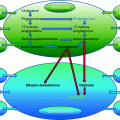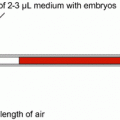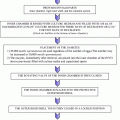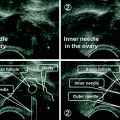Fig. 27.1
Detailed protocol for natural cycle IVF combined with IVM treatment (Based on Lim et al. [27] with modification)
In addition, it has been reported that the clinical outcomes of different infertility causes (tubal factor, male factor, unexplained infertility, combination of tubal and male factors, and other/mixed factors) with natural cycle IVF combined with IVM treatment were evaluated [28]. They found that there were no significant differences in the rates of IVM, IVF, and cleavage as well as in the clinical pregnancy (30.4–46.9%) and live birth rates among the five subgroups, which suggests that natural cycle IVF and IVM treatment are the suitable treatments for infertility of various causes with acceptable pregnancy and live birth rates.
Interestingly, it also has been reported that the blastocysts produced from the immature oocytes derived from small follicles during natural cycle IVF combined with IVM treatment can be safely vitrified and give a healthy live birth, confirming that the presence of the leading follicle during natural cycle IVF combined with IVM treatment does not detrimentally affect the viability and health of the immature oocytes derived from small follicles [29]. Furthermore, it may be interesting to know that still whether or not during natural cycle IVF combined with IVM treatment there are differences in pregnancy and implantation rates between women with and without the presence of mature oocytes obtained at the time of the retrieval. It has been found that although the clinical pregnancy rates are not different regarding the retrieval of mature oocytes or the time of the egg retrieval, the live birth rate is higher (P < 0.05) when the mature oocytes are obtained at the time of the egg retrieval [30].
Table 27.1 shows the cycle outcome of Group A (women with mature oocytes) and Group B (women without mature oocytes). In Group A, a total of 739 mature oocytes were obtained at the time of retrieval from 314 cycles of natural IVF combined with IVM treatment with an average of 2.4 ± 1.6 per woman. Of these 739 mature oocytes, 644 (87.1%) were fertilized and 610 (94.7%) cleaved. There were also 2780 immature oocytes of which 1826 (65.7%) matured in vitro and 1457 (79.7%) were fertilized. In Group B, a total of 515 immature oocytes were retrieved from 55 cycles with an average of 9.4 ± 4.9 per patient. Of these 515 immature oocytes, 363 (70.5%) were matured in vitro and 294 (81.0%) were fertilized. There were no differences between the two groups in terms of total fertilization (81.9% vs. 81.0%) and embryo cleavage (92.1% vs. 89.1%) rates. Moreover, the quality of embryos was not different between the groups. Following embryo transfer, the clinical pregnancy rates and implantation rates between the groups were not different (40.1% vs. 34.5% and 16.2% vs. 15.0% in Group A and Group B, respectively). However, the live births per embryo transfer (29.6% vs. 16.4%) and miscarriage per clinical pregnancy (26.2% vs. 52.6%) rates were significantly different between Group A and Group B.
Table 27.1
Comparison of pregnancy and live birth rates of natural cycle IVF/M treatment in women with or without mature oocytes collected at the time of egg retrieval (Reproduced from Yang et al. [30])
Groups | A | B | P value |
|---|---|---|---|
No. of patients (cycles) | 283 (314) | 53 (55) | – |
Age (mean ± SD) | 31.2 ± 3.6 | 30.4 ± 3.3 | NS |
No. of mature oocytes retrieved (mean ± SD) | 739 (2.4 ± 1.6) | – | – |
No. of immature oocytes retrieved (mean ± SD) | 2780 (8.9 ± 5.0) | 515 (9.4 ± 4.9) | NS |
No. of oocytes matured in vitro (%) | 1826 (65.7) | 363 (70.5) | NS |
Total numbers of oocytes matured (mean ± SD) | 2565 (8.2 ± 3.5) | 363 (6.6 ± 3.5) | NS |
No. of oocytes fertilized (%) | 2101 (81.9) | 294 (81.0) | NS |
No. of in vivo-matured oocytes fertilized (mean ± SD) | 644 (2.1 ± 1.4) | – | – |
No. of in vivo-matured oocytes cleaved (mean ± SD) | 610 (1.9 ± 1.4) | – | – |
No. of in vitro-matured oocytes fertilized (mean ± SD) | 1457 (5.1 ± 1.4) | 294 (4.9 ± 2.2) | NS |
No. of in vitro-matured oocytes cleaved (mean ± SD) | 1324 (4.2 ± 2.6) | 262 (4.8 ± 2.7) | NS |
No. of zygotes cleaved (%) | 1934 (92.1) | 262 (89.1) | NS |
No. of embryos transferred (mean ± SD) | 859 (2.7 ± 0.4) | 147 (2.7 ± 0.5) | NS |
No. of clinical pregnancies (%) | 126 (40.1) | 19 (34.5) | NS |
No. of embryos implanted (%) | 139 (16.2) | 22 (15.0) | NS |
Live births per cycle (%)* | 93 (29.6) | 9 (16.4) | 0.043 |
Singleton | 74 | 9 | – |
Twins | 18 | – | |
Triplets | 1 | – | |
Miscarriage rate per clinical pregnancies (%)* | 33 (26.2) | 10 (52.6) | 0.019 |
During natural cycle IVF/M, it is impossible to predict the stage of oocyte maturity according to the follicular size. In fact, as seen in the patients of Group A, many in vivo mature oocytes were harvested from the small-sized follicles (<12 mm in diameter) than the leading follicles (≥12 mm in diameter). This observation should spur renewed interest in studying the process of folliculogenesis, and the resumption of meiosis during natural cycles and should caution in relying on a particular size of the follicle to predict oocyte maturity.
Lim et al. [27] have shown that the optimal sizes of follicles could be between 12 and 14 mm in diameter for natural cycle IVF combined with IVM treatment, which can prevent premature ovulation [25, 26]. Surprisingly, we found that some mature oocytes can be retrieved from relatively small follicles (between 8 and 10 mm in diameter). The embryo development from in vivo-matured oocytes had better quality than in vitro-matured oocytes, resulting in higher clinical pregnancy rate in the natural cycle IVF combined with IVM treatment with in vivo-matured oocytes compared to the cycles without in vivo-matured oocytes [25, 26]. However, the data show that there were no significant differences in terms of clinical pregnancy and implantation rates when the natural cycle IVF combined with IVM treatment with or without in vivo-matured oocytes was retrieved at the time of oocyte retrieval (Table 27.1).
Recently, it has been reported that non-dominant small follicles are a promising supplementary source of mature oocytes and that their use increase the live birth rate in natural cycle IVF treatment [31]. Also they demonstrate that the blastocysts from non-dominant follicles are as competent as those from dominant follicles in terms of pregnancy. This report confirms the notion that mature oocytes can be retrieved from non-dominant or leading follicles during natural cycle treatment.
Table 27.2 shows the pregnancy outcomes based on the mature oocytes retrieved from the different-sized follicles at the time of oocyte retrieval. Whether the mature oocytes were retrieved from leading follicles or small follicles, there were no differences in fertilization (81.8, 81.8, and 82.2%, respectively) and embryo cleavage (91.9, 93.9, and 90.5%, respectively) rates among those subgroups. Also the quality of embryos was not different among the groups assessed by morphology. In addition, there were no statistically significant differences in terms of clinical pregnancy (44.0, 34.9, and 38.5%), implantation (16.8, 14.7, and 16.6%), live birth per embryo transfers (30.7, 26.7, and 30.8%), and miscarriage per clinical pregnancy (30.3, 23.3, and 20.0%) rates among those subgroups.
Table 27.2
Comparison of pregnancy and live birth rates based on the presence of mature oocytes retrieved from the leading or non-leading follicles at the time of egg retrieval (Reproduced from Yang et al. [30])
Subgroups of A | 1
Stay updated, free articles. Join our Telegram channel
Full access? Get Clinical Tree
 Get Clinical Tree app for offline access
Get Clinical Tree app for offline access

|
|---|




